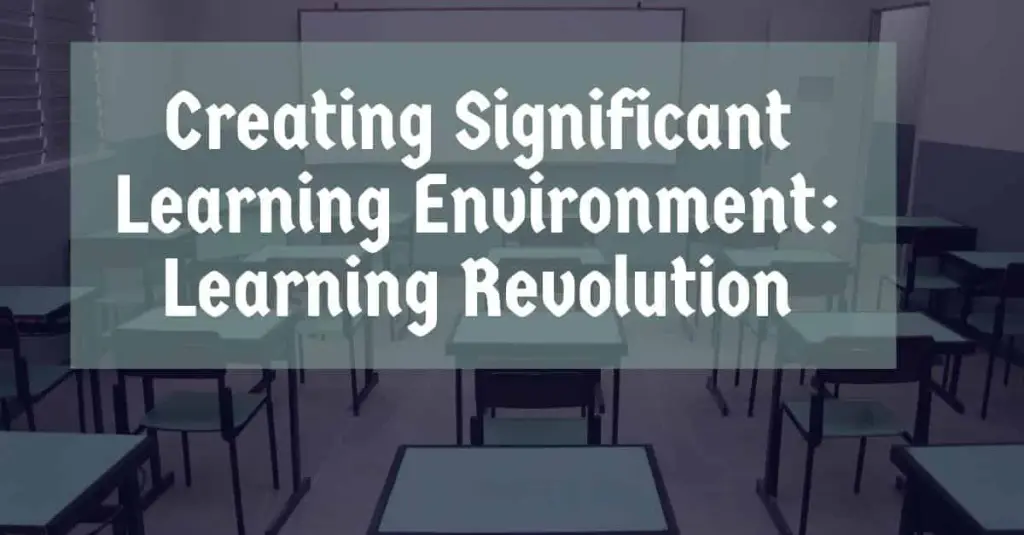Creating Significant Learning Environment: Learning Revolution

Sir Ken Robinson’s advocated strongly for a “learning revolution” (Robinson, 2006). He believes fundamental rethinking will save education. And Daniel Pink’s exploration of intrinsic motivation (Pink, 2011) offers powerful insights to guide our role as an educator. In exploring how these ideas can influence my approach to improve student potential, we as educators need to think about unearthing Hidden Talents in our learners. Robinson posits that human potential like mineral resources within the earth is often “buried deep” (Robinson, 2006). Our role is to create a learning environment that uncovers, refines, and nurtures these hidden talents. This aligns with Pink’s concept of intrinsic motivation, which thrives when individuals are driven by autonomy, mastery, and purpose (Pink, 2011). Therefore, we must make learning more personalized as a basis for Robinson’s Learning Revolution. The traditional, “one-size-fits-all” education doesn’t resonate with Robinson’s vision of a learning revolution (Robinson, 2006). Pink further emphasizes the need for intrinsic motivation, which can be stifled by standardized or normalization approaches (Pink, 2011).
Here are some suggestions on how to create a personalized learning revolution in our classroom:
- Identifying Student Passions: Unearth student interests and tailor learning experiences to ignite their curiosity. This fosters autonomy and intrinsic motivation (Robinson, 2006).
- From the COVA learning approach – Choice and Ownership: Offer students choices in their learning paths and projects. This empowers them to take ownership of their learning journey (Pink, 2011).
- Differentiated Instruction: Adapting our teaching to address individual learning styles, strengths, and weaknesses. This allows all students to experience a sense of mastery in their unique areas (Pink, 2011).
In the process of nurturing dreams and fostering autonomy we must think about Robinson’s tender reminder to “tread softly” which speaks to the fragility of student dreams (Robinson, 2006). This aligns with Pink’s idea of nurturing intrinsic motivation (Pink, 2011). To create a space where dreams can flourish, we are to create a “Safe Learning Environment” which fosters an environment where students feel comfortable exploring, taking risks, and making mistakes without fear of judgment. This creates psychological safety, crucial for learning (Pink, 2011). As educators, we are to create engaging environments that is designed to spark curiosity, encourage exploration, and promote critical thinking. Move beyond note memorization and foster a love for learning (Robinson, 2006). There is great need to incorporate project-based learning that allows students to apply their knowledge and solve real-world problems. This connects learning to purpose and fosters collaboration (Robinson, 2006). We need to provide “Positive Feedback and Encouragement” to focus on providing positive feedback that highlights student growth and effort. This builds confidence and intrinsic motivation (Pink, 2011). We must “Celebrate Diversity” by embracing and celebrating the unique talents, perspectives, and learning styles present in your classroom. This creates a sense of belonging and allows all students to thrive (Robinson, 2006).
Teachers and school system should move beyond the “Carrot and Stick” or the traditional education model which often relies on rewards and punishments (the “carrot and stick”) as motivators. However, Robinson and Pink advocate for a shift towards fostering autonomy, mastery, and purpose (Robinson, 2006; Pink, 2011). Extrinsic vs. Intrinsic Motivation: Rewards and punishments focus on external validation rather than inherent learning joy. When the rewards stop, so may the motivation (Pink, 2011). Fostering a Love for Learning: When students are driven by autonomy, mastery, and purpose, the motivation comes from within. This creates lifelong learners who are passionate about learning and self-improvement (Pink, 2011).
By incorporating these ideas, my learning philosophy will evolve to ensure students are empowered to take ownership of their learning journey (Pink, 2011). To focus on intrinsic motivation from learners thereby fostering a love for learning (Robinson, 2006). To ensure we adopt personalized learning experiences that cater to individual needs and interests (Robinson, 2006). And creates a safe and supportive environment where students feel comfortable exploring and growing collaboratively (Pink, 2011). Robinson and Pink inspire us to become a catalyst for a learning revolution in our classrooms. We can leverage their ideas to nurture students’ natural curiosity, ignite their passion for learning, and empower them to reach their full potential.
Bibliography
Pink, D. H. (2011). Drive: The surprising truth about what motivates us. Penguin Random House.
Robinson, K. (2006). Bring on the learning revolution! TED Talks. https://www.ted.com/talks/sir_ken_robinson_bring_on_the_learning_revolution?language=en
